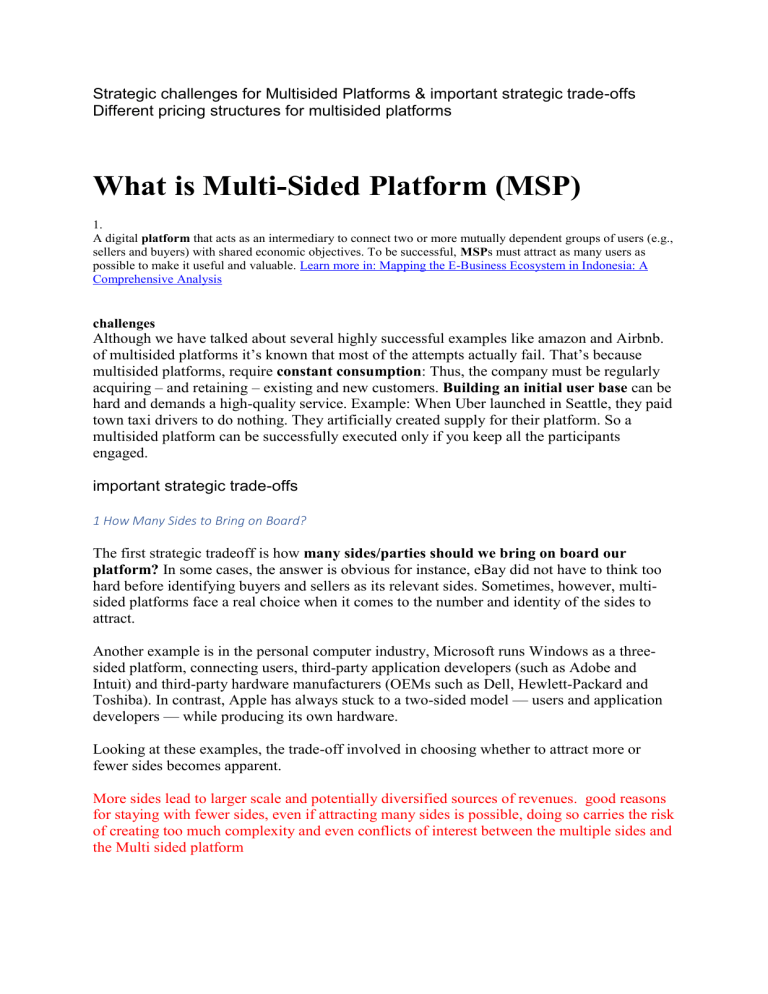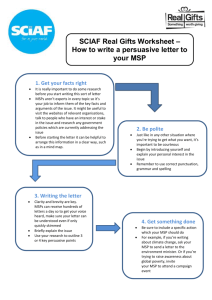
Strategic challenges for Multisided Platforms & important strategic trade-offs Different pricing structures for multisided platforms What is Multi-Sided Platform (MSP) 1. A digital platform that acts as an intermediary to connect two or more mutually dependent groups of users (e.g., sellers and buyers) with shared economic objectives. To be successful, MSPs must attract as many users as possible to make it useful and valuable. Learn more in: Mapping the E-Business Ecosystem in Indonesia: A Comprehensive Analysis challenges Although we have talked about several highly successful examples like amazon and Airbnb. of multisided platforms it’s known that most of the attempts actually fail. That’s because multisided platforms, require constant consumption: Thus, the company must be regularly acquiring – and retaining – existing and new customers. Building an initial user base can be hard and demands a high-quality service. Example: When Uber launched in Seattle, they paid town taxi drivers to do nothing. They artificially created supply for their platform. So a multisided platform can be successfully executed only if you keep all the participants engaged. important strategic trade-offs 1 How Many Sides to Bring on Board? The first strategic tradeoff is how many sides/parties should we bring on board our platform? In some cases, the answer is obvious for instance, eBay did not have to think too hard before identifying buyers and sellers as its relevant sides. Sometimes, however, multisided platforms face a real choice when it comes to the number and identity of the sides to attract. Another example is in the personal computer industry, Microsoft runs Windows as a threesided platform, connecting users, third-party application developers (such as Adobe and Intuit) and third-party hardware manufacturers (OEMs such as Dell, Hewlett-Packard and Toshiba). In contrast, Apple has always stuck to a two-sided model — users and application developers — while producing its own hardware. Looking at these examples, the trade-off involved in choosing whether to attract more or fewer sides becomes apparent. More sides lead to larger scale and potentially diversified sources of revenues. good reasons for staying with fewer sides, even if attracting many sides is possible, doing so carries the risk of creating too much complexity and even conflicts of interest between the multiple sides and the Multi sided platform Strategy Challenge No. 2 Multisided Platform Governance Rules As MSPs create value by facilitating interactions between third parties, a key part of their strategy should be some regulation of third-party actions, beacsue they affect the value of the MSP’s entire ecosystem and customer proposition.23 MSPs can regulate their various customers by resorting to governance rules Rules regulating access to the MSP: Who is allowed to join? Rules regulating interactions on the MSP: What are the various parties on the platform allowed to do? in the smartphone market, the two leading MSPs differ significantly in their governance rules. Apple places relatively tight restrictions on third-party developers for its iOS two-sided platform, while Google is much more liberal with respect to developers for its three-sided Android platform. For example, Google allows developers to use a variety of third-party tools in building their Android apps and accepts most new apps. But developers for Apple’s iOS are restricted to a fixed set of Apple-supplied tools. Furthermore, approval of new apps takes several weeks in Apple’s iPhone App Store, and Apple routinely rejects applications that it does not deem of satisfactory quality or simply a “good fit” for the iPhone. (Unsurprisingly, Apple’s criteria are viewed as arbitrary by some developers.26) Strategy Challenge No. 3: Multisided Platform Pricing Structures How should MSPs choose their pricing structures that’s the final strategic trade-off for multi sided platforms. The first pricing structure is that For each group, charge a higher price when the group in question has less price sensitivity. Price sensitivity is the degree to which demand changes when the cost of a product or service changes. The price sensitivity on any given side of an MSP can be estimated by the availability of substitute services — or simply by the bargaining power that the MSP has over that particular participant group. 1. If there is no priced transaction between the sides, then charge more to the side that stands to benefit more from the presence of the other side or sides. but also straightforward. For instance, business conference organizers typically charge attendees but not invited speakers. 2. If there is a priced transaction between two sides, then charge more to the side that can extract more value from the other side. If side A gets a particularly good deal from side B in a monetary transaction, the MSP should charge more to side A in order not to excessively penalize side B; otherwise, side B might not derive enough value from the MSP to warrant participation. Discussion point: What do you think is the best multi-sided platform? And which group of users do they connect? Before we continue what do you guys think what can cause a market failure when building a multisided platform? Common obstacles when building multi-sided platforms The first potential source of MSP market failure is the risk that too much competition within one side of an MSP might reduce the incentive to invest in developing highquality products or services. This is the main reason that video game console makers maintain relatively tight control over access by third-party game developers even today. excessive competition between developers on any given console could reduce the profits that each developer can extract, to the point where they may no longer find it profitable to invest in groundbreaking projects. As a result, the Multi sided platforms (console makers) restrict entry of developers so that those who are licensed are able to make a sufficient return on their investments.28 The second one is a situation called the market for lemons. George Akerlof examined the market for used cars and considered a situation known as the market for lemons, where the sellers are better informed than the buyers. The effect of the informed seller and uninformed buyer produces a “lemons” problem. At any given price, all the lemons (so the bad used cars) and only a few of the good cars are offered, and the buyer—not knowing the quality of the car—isn’t willing to pay as much as the actual value of a high-value car offered for sale. This causes the market to collapse. Third, without some form of governance by the MSP, each constituent might fail to take actions or investments that would have positive spillover effects for the MSP. Multi sided platfors are well-advised to consider enforcing governance rules.

